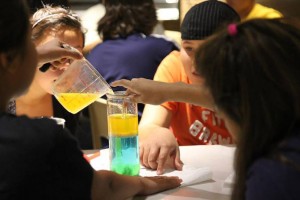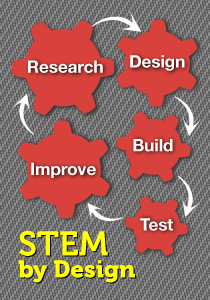The Wonder of STEM
A MiddleWeb Blog
I blinked in surprise. My oldest son sat across the table from me. He was finishing up his first year of college. In high school he’d made a 35 on the ACT (having missed a math problem because – according to him – he made a silly mistake.) He was acing his coursework in calculus, physics, as he always had in mathematics and sciences. And now at dinner, he had just announced that he’d decided on his major. He was going to major in English – specifically, creative writing.
His explanation was simple. He was tired of subjects with “right and wrong” answers. He wanted classes that allowed him to think. He wanted to wrestle with responses and ideas. After a physics test on which he made the highest grade in the large freshman class, he wrote beside his posted grade: “Anything a Physics major can do an English major can do better.”
This happened in the 1980s. I know that the maths and sciences require students to think, but at what level was inquiry-based teaching and critical thinking emphasized in ‘80s STEM-related classes? I don’t have a hard number, but in those days it didn’t seem to happen in most high school classes and certainly not in those supersized freshman level college classes.
Fast forward to today’s K-12 math and science classes. I wonder how many math and science teachers still expect students to follow a specific predetermined procedure that gets them to the predetermined “right” answer. And how well do these canned lessons prepare them for today’s world?
Some sunshine
Before heaving a sigh of despondency, let me tell you another story. I recently watched a video of a teacher in Mobile, Alabama working with her 2nd graders. They were sitting on a rug in front of the board with nothing but their brains – no paper, pencil, or other tools. The teacher wrote the number 53 on the board. Then she told her students, “Think about this number. 53 is the answer. How did we get this answer?”
You could tell the kids had done this before. They studiously regarded the two-digit number, and when they had a response they put their “quiet thumb” up under their chins. One by one, the teacher asked them to share how they arrived at the answer, until all the students’ solutions were on the table. Then they talked about all the answers. The roads to 53 are amazing and creative.
STEM can grow better thinking

That’s the part of the STEM process that can revolutionize our subject areas. In our middle grades curriculum designs, we want students recognizing that there are multiple ways to solve a problem, and then coming up with as many as they can. And we don’t have the corner on the market. Today this process is beginning in elementary schools! (I visited a kindergarten team meeting in Birmingham, AL where the teachers decided to pose this problem to their students: “The answer is 20 cookies. What is the story?” Delicious.)
I wonder what my son would have thought about math and science if he had been taught to tangle with a variety of approaches to solving problems and conducting investigations — to look at a possible math and science career as an a adventure and not a life filled with routine and predictability.
I expect he would have still majored in English. He’s a really good writer. But maybe his reason for majoring in English would have been different, and not reflected his discouragement with math and science – subjects that should engender wonder and excitement in young minds.
STEM needs to be about wonder
In my past blog posts I’ve attempted to describe various parts of the engineering design process, but I feel especially passionate about this one. This element of excited curiosity is critical to developing tomorrow’s workforce, but it’s also critical to developing students who enjoy learning, who can see possibilities, and who arrive at potential solutions. It’s critical to tomorrow’s society, when you get right down to it.
Today’s teachers do have to teach in a way that allows students to explore, create, and develop multiple solutions for problems before reaching consensus on the best one to try. That’s the only way we’ll ever put the “E” in STEM. And that’s the only way we’ll ever turn out students who can solve the problems our world faces.
Problem-solving, problem-solving, problem-solving. How do you help your students do that? How would you like to help your students do that? Regardless of your subject area, have you ever had really good professional learning opportunities — the kind that helped you learn how to support your students as they devise multiple pathways to problems? Just wondering . . .






























Love this, Anne!!! I taught at the 2nd and 3rd grade level, and loved the type of teaching that you describe. It keeps the excitement and questions everything.
You know, I think many talented teachers have always taught this way – being aware the helping kids learn to think and solve problems was what would help them the most in life. And it does add excitement and ownership to the learning process.
Anne, Reading your blogs really gets me thinking! Your question about receiving professional development that helps teachers to support their students as they problem-solve is right on. My question is, how can teachers effectively model true inquiry and problem-solving if they have never had the opportunity to experience the model themselves? The National Institute of Health’s (NIH) Curriculum supplement series (http://science.education.nih.gov/customers.nsf/WebPages/CSHome) focus on the process of scientific inquiry. I have used the supplement, “Doing Science: The Process of Scientific Inquiry” with teachers as an introduction to the inquiry process and to help them better understand how to model the process in their classrooms.
You are SO “right on” in your response, Cal! Ongoing professional learning is the only way teachers have a chance to get this right . . . and keep on getting it right. Think about doctors, dentists, and other groups of professionals who spend time learning and staying on top of new ideas and researching things that work. Of course, teachers need these opportunities! But the opportunities are sometimes far and few between, not of good quality, and with little or no follow-up. And they often occur at the teachers own expense. I remember the days when five of us science teachers threw a cooler with food and drink in the trunk of a car and drove to an NSTA meeting two states away, where we all stayed in the same room at the Days Inn. We were on our own with trying keep up with our learning. I really think the tide is beginning to shift – don’t you?
Anne,
As always, a thought-provoking post. One pivotal week of my professional learning came in the 90’s, when Masschusetts was implementing a statewide systemic initiative to change math and science learning. Among other things, we were given what we were not yet calling design challenges to solve. I particularly remember us being challenged to create a working model of a maple tree seed pod. Period. In another activity, led by the talented Sue Doubler (of TERC and Lesley University), we tried to answer one question: How many roofs have you lived under?
Of course, in both of these experiences, as individuals, teams, and a whole class, we all soon realized that there was ambiguity built into the initiating challenge or question. On purpose. We were left to struggle with what to do with that ambiguity.
Should the maple seed pod be a double pod (the one that looks a bit like dragonfly wings?) or a single? Did it matter? What does a working model mean? Did this have to look anything at all like a maple seed pod, or did it just have to spin? Could it work if it didn’t have the same shape? Even after we answered those Q’s, of course we had to solve the problem. Likewise: What counts as “living” somewhere? Do you live in a dorm and therefore count that building’s roof? If you live in a basement apartment, are you living under a “roof”?
While the ambiguity and the possibiity of multiple solutions exists in every field, the E is a great vehicle for bringing these elements of engagement into the classroom.
An addendum:
Hi, again, Anne (and others): Just want to clarify that in my post I was speaking of two different types of examples of ambiguous problems to solve: An engineering probem (one where we were trying to get something to work a certain way – the working model of the maple seed) and an inquiry-based problem (the one where we were trying to answer a question – the “how many roofs” question). I see these as two distinct, but highly effective starting points for engagement and wonder. Their efficacy, I think, comes in large part because of the ambiguity, which prevents the solution from becoming formulaic and predictable. There! Much better thinking in the afternoon!
Pretty good thinking in both the morning and the afternoon, Carolyn! I’m sitting here mulling over the word, “ambiguity.” That’s a concept I hadn’t really honed on . . . and you’re right. Deliberate ambiguity creates a lot of opportunity for divergent thinking. I’m trying to think of other ambiguous ideas that middle schoolers might be able to struggle with – really I’m trying to think of ideas that would be good discussion starters and would begin building the ability to grapple with ambiguous ideas. It’s easier for me to think of examples in literature than in STEM. Help, someone! Ambiguity is a quality, top-notch idea.
Mrs. Andrews,
Are you the same Mrs. Andrews who taught 2nd grade at Hillview Elementary School? If so, I was one of your students. You were awesome and I learned so much from you. You, Ms. Watterson, and Ms. Tingle were very influential in many of our lives. Thank you for your generosity in sharing of yourself and your skills.
How wonderful to hear from you!!! Yes, I taught 2nd grade with Mrs. Tingle and Mrs. Watterson at HillView. You kids were super and never afraid to try anything that we dreamed up. Thank you for your gracious comments. I hope you are doing well. Do you teach school? I think you might because you read this blog. Best Wishes!!!!!
Mrs. Andrews,
No, I do not teach school at all! I do not have the patience for it. My sister is a paraeducator and I admire her for that. I handle state and federal regulatory filings for 180 ambulatory surgery centers and 5 surgical hospitals. I read this article because I was googling trying to locate you and Mrs. Watterson. Mrs. Tingle went to church with me but I didn’t find out that it was her until she passed. I wondered where you have moved to and what you are doing now. I know Hillview is not the same but I still ride by and have such fond memories and want to connect with people. I saw Ms. Rutledge (5th grade) not long ago at the grocery store when I was visiting with my parents.